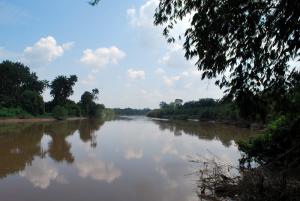‘Current test’ for water pollution

Sg Langat where the water sampling was done Copyright : Tianyake / Flickr
A simple test of electrical conductivity could be used as a parameter for water quality, according to new research published in the Journal of Tropical and Agricultural Sciences.
The research investigated whether this single parameter could be used instead of the more complex current tests used in Malaysia to measure water pollution. The author believes the test should be included in the water quality index in the future.
Currently, the Malaysian Water Quality Index (WQI) is based on six water parameters. This allows a lot of data to be broken down into six measures, but there are weaknesses, and it is certainly not comprehensive.
The use of conductivity tests can inform of sulfate, bicarbonate, and chlorides of calcium, magnesium, and sodium in water, and is used in some still water lakes, but isn’t currently used in running rivers.
Yap CK, from Universiti Putra Malaysia, took nine periodic samplings at eight sites along the Malaysian Langat river, including both polluted downstream and unpolluted upstream sites.
The results show that there are consistently higher levels of electrical conductivity in the more polluted downstream, and this was in line with two current measures – dissolved oxygen and suspended solids.
Since it is much easier and faster to measure electrical than these two factors, its use as a single indicator of water pollution in tropical rivers is proposed.
For more information about each research, please contact:
Yap Chee Kong
Department of Biology
Faculty of Science
Universiti Putra Malaysia
43400, Serdang, Selangor, Malaysia
Email: yapckong@hotmail.com
Tel: +(603) 8946 6616; Mobile: +(6012) 506 6713.
About Pertanika Journal of Tropical Agricultural Science (JTAS)
Pertanika Journal of Tropical Agricultural Science (JTAS) is published by Universiti Putra Malaysia in English and is open to authors around the world regardless of nationality. Beginning 2012, it would be published four times a year in February, May, August and November. Other Pertanika series include Pertanika Journal of Science & Technology (JST), and Pertanika Journal of Social Sciences & Humanities (JSSH).
JTAS aims to provide a forum for high quality research related to tropical agricultural research. Areas relevant to the scope of the journal include: agricultural biotechnology, biochemistry, biology, ecology, fisheries, forestry, food sciences, entomology, genetics, microbiology, pathology and management, physiology, plant and animal sciences, production of plants and animals of economic importance, and veterinary medicine. The journal publishes original academic articles dealing with research on issues of worldwide relevance.
Website: http://www.pertanika.upm.edu.my/
The paper is available from this link:
http://www.pertanika.upm.edu.my/Pertanika%20PAPERS/JTAS%20Vol.%2036%20(4)%20Nov.%202013/02%20Page%20299-310.pdf
For more information about the journal, contact:
The Chief Executive Editor (UPM Journals)
Head, Journal Division, UPM Press
Office of the Deputy Vice Chancellor (R&I)
IDEA Tower 2, UPM-MDTC Technology Centre
Universiti Putra Malaysia
43400 Serdang, Selangor
Malaysia.
Phone: +(603) 8947 1622 | +(6016) 217 4050
Email: nayan@upm.my
Date of Release: 3 Mar, 2014.
Acknowledgements
The Chief Executive Editor, UPM Journals
Associated links
Media Contact
All latest news from the category: Agricultural and Forestry Science
Newest articles

Simplified diagnosis of rare eye diseases
Uveitis experts provide an overview of an underestimated imaging technique. Uveitis is a rare inflammatory eye disease. Posterior and panuveitis in particular are associated with a poor prognosis and a…

Targeted use of enfortumab vedotin for the treatment of advanced urothelial carcinoma
New study identifies NECTIN4 amplification as a promising biomarker – Under the leadership of PD Dr. Niklas Klümper, Assistant Physician at the Department of Urology at the University Hospital Bonn…

A novel universal light-based technique
…to control valley polarization in bulk materials. An international team of researchers reports in Nature a new method that achieves valley polarization in centrosymmetric bulk materials in a non-material-specific way…





















